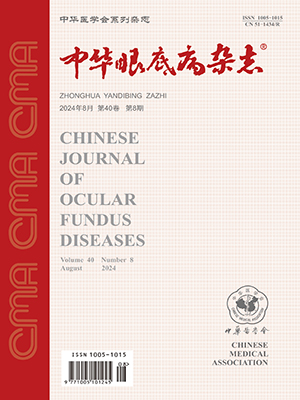| 1. |
Dorey CK, Wu G, Ebenstein D, et al. Cell loss in the aging retina: relationship to lipofusc in accumulation and macular degeneration[J]. Invest Ophthalmol Vis Sci, 1989, 30(8): 1691-1699.
|
| 2. |
Soliman AZ, Silva PS, Aiello LP, et al. Ultra-wide-field retinal imaging in detection, classification and management of diabetic retinopathy[J]. Semin Ophthalmol, 2012, 27(5): 221-227. DOI: 10.3109/08820538.2012.708812.
|
| 3. |
Mrinali P, Kiss S. Ultra-wide-field fluoreseein angiography in retinal disease[J]. Curr Opin Ophthalmol, 2014, 25(3): 213-220. DOI: 10.1097/ICU.0000000000000042.
|
| 4. |
Heussen FM, Tan CS, Sadda VR. Prevalence of peripheral abnormalities on ultra-widefield greenlight (532 nm) autofluorescence imaging at a tertiary care center[J]. Invest Ophthalmol Vis Sci, 2012, 53(10): 6526-6531. DOI: 10.1167/iovs.12-9909.
|
| 5. |
Silva PS, Cavallerano JD, Sun JK , et al. Nonmydriatic ultrawide field retinal imaging compared with dilated standard 7-field 35-mm photography and retinal specialist examination for evaluation of diabetic retinopathy[J]. Am J Ophthalmol, 2012, 154(3): 549-559. DOI: 10.1016/j.ajo.2012.03.019.
|
| 6. |
Holz FG, Bellman C, Staudt S, et al. Fundus autofluorescence and development of geographic atrophy in age-related macular degeneration[J]. Invest Ophthalmol Vis Sci, 2001, 42(5): 1051-1056.
|
| 7. |
Sepah YJ, Akhtar A, Sadiq MA, et al. Fundus autofluorescence imaging: fundamentals and clinical relevance[J]. Saudi J Ophthalmol, 2014, 28(2): 111-116. DOI: 10.1016/j.sjopt.2014.03.008.
|
| 8. |
Nomura Y, Takahashi H, Tan X, et al. Widespread choroidal thickening and abnormal midperipheral fundus autofluorescence characterize exudative age-related macular degeneration with choroidal vascular hyperpermeability[J]. Clin Ophthalmol, 2015, 9: 297-304. DOI: 10.2147/OPTH.S78210.
|
| 9. |
Witmer MT, Kozbial A, Daniel S, et al. Peripheral autofluorescence findings in age-related macular degeneration[J]. Acta Ophthalmol, 2012, 90(6): 428-433. DOI: 10.1111/j.1755-3768.2012.02434.x.
|
| 10. |
Tan CS, Heussen F, Sadda SR. Peripheral autofluorescence and clinical findings in neovascular and non-neovascular age-related macular degeneration[J]. Ophthalmology, 2013, 120(6): 1271-1277. DOI: 10.1016/j.ophtha.2012.12.002.
|
| 11. |
Writing Committee for the OPTOS PEripheral RetinA (OPERA) Study (Ancillary Study of Age-Related Eye Disease Study 2), Domalpally A, Clemons TE, et al. Peripheral retinal changes associated with age-related macular degeneration in the Age-Related Eye Disease Study 2: Age-Related Eye Disease Study 2 report number 12 by the Age-Related Eye Disease Study 2 Optos PEripheral RetinA (OPERA) Study Research Group[J]. Ophthalmology, 2017, 124(4): 479-487. DOI: 10.1016/j.ophtha.2016.12.004.
|
| 12. |
Klufas MA, Yannuzzi NA, Pang CE, et al. Feasibility and clinical utility of ultra-widefield indocyanine green angiography[J]. Retina, 2015, 35(3): 508-520. DOI: 10.1097/IAE.0000000000000318.
|
| 13. |
Imamura Y, Fujiwara T, Spaide RF. Fundus autofluorescence and visual acuity in central serous chorioretinopathy[J]. Ophthalmology, 2011, 118(4): 700-705. DOI: 10.1016/j.ophtha.2010.08.017.
|
| 14. |
Pang CE, Shah VP, Sarraf D, et al. Ultra-widefield imaging with autofluorescence and indocyanine green angiography in central serouschorioretinopathy[J]. Am J Ophthalmol, 2014, 158(2): 362-371. DOI: 10.1016/j.ajo.2014.04.021.
|
| 15. |
Shin JY, Choi HJ, Lee J, et al. Fundus autofluorescence findings in central serous chorioretinopathy using two different confocalscanning laser ophthalmoscopes: correlation with functional and structural status[J]. Graefe’s Arch Clin Exp Ophthalmol, 2016, 254(8): 1537-1544. DOI: 10.1007/s00417-015-3244-3.
|
| 16. |
Reznieek L, Seidensticker F, Stumpf C, et al. Systematic analysis of wide-field fundus autofIuorescence (FAF) imaging in posterior uveitis[J]. Curr Eye Res, 2014, 39(2): 164-171. DOI: 10.3109/02713683.2013.834938.
|
| 17. |
Heussen FM, Vaseoncelos-Santos DV, Pappuru RR, et al. Ultra-wide-field green-light (532 nm) autofluorescence imaging in chronic Vogt-Koyanagi-Harada disease[J]. Ophthalmic Surg Lasers Imaging, 2011, 42(4): 272-277. DOI: 10.3928/15428877-20110505-01.
|
| 18. |
Mesquida M, Llorene V, Fontenla JR, et al. Use of ultra-wide-field retinal imaging in the management of active Behçet retinal vasculitis[J]. Retina, 2014, 34(10): 2121-2127. DOI: 10.1097/IAE.0000000000000197.
|
| 19. |
Hashimoto H, Kishi S. Ultra-wide-field fundus autofluorescence in multiple evanescent white dot syndrome[J]. Am J Ophthatmol, 2015, 159(4): 698-706. DOI: 10.1016/j.ajo.2015.01.015.
|
| 20. |
Seidensticker F, Neubauer AS, Wasfy T, et al. Wide-field fundus autofluorescence corresponds to visual fields in ehorioretinitis patients[J]. Clin Ophthalmol, 2011, 5(11): 1667-1671. DOI: 10.2147/OPTH.S26224.
|
| 21. |
Oishi A, Oishi M, Ogino K, et al. Wide-field fundus autofluorescence for retinitis pigmentosa and cone/cone-rod dystrophy[J]. Adv Exp Med Biol, 2016, 854: 307-313. DOI: 10.1007/978-3-319-17121-0_41.
|
| 22. |
Ogura S, Yasukawa T, Kato A, et al. Wide-field fundus autofluorescence imaging to evaluate retinal function in patients with retinitis pigmentosa[J]. Am J Ophthalmol, 2014, 158(5): 1093-1098. DOI: 10.1016/j.ajo.2014.07.021.
|
| 23. |
Oishi M, Oishi A, Ogino K, et al. Wide-field fundus autofluorescence abnormalities and visual function in patients with cone and cone-roddystrophies[J]. Invest Ophthalmol Vis Sci, 2014, 55(6): 3572-3577. DOI: 10.1167/iovs.14-13912.
|
| 24. |
Oishi A, Ogino K, Makiyama Y, et al. Wide-field fundus autofluorescence imaging of retinitis pigmentosa[J]. Ophthalmology, 2013, 120(9): 1827-1834. DOI: 10.1016/j.ophtha.2013.01.050.
|
| 25. |
Trichonas G, Traboulsi EI, Ehlers JP. Correlation of ultra-widefield fundus autofluorescence patterns withthe underlying genotype in retinaldystrophies and retinitis pigmentosa[J]. Ophthalmic Genet, 2017, 38(4): 320-324. DOI: 10.1080/13816810.2016.1227450.
|
| 26. |
Witmer MT, Cho M, Favarone G, et al. Ultra-wide-field autofluorescence imaging in non-traumatic rhegmatogenous retinal detachment[J]. Eye, 2012, 26(9): 1209-1216. DOI: 10.1038/eye.2012.122.
|
| 27. |
Salvanos P, Navaratnam J, Ma J, et al. Ultra-wide field autofluorescence imaging in the evaluation of scleral buckling surgery for retinal detachment[J]. Retina, 2013, 33(7): 1421-1427. DOI: 10.1097/IAE.0b013e318283138d.
|




